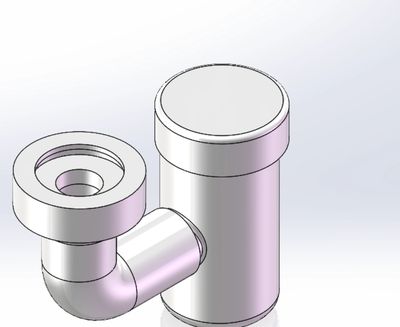research & design PROJECTS
water faucet
Collaborated with a team to research water purification methods, focusing on challenges such as microplastic release and bacterial growth. Led design of a faucet-mounted prototype using an inorganic membrane with ceramic and stainless-steel housing to replace plastic components. I assisted in testing a removable, reusable, and low-cost filter and implemented design refinements to improve convenience, reusability, and cost efficiency.

forehand crutch
The utility model is a crutch designed for elderly users, comprising a first rod, with a handle mounted vertically on its outer wall. One end of the first rod is fixedly connected to an armrest, while the other end connects to a second rod. Inside the second rod, there is a third rod, which is fixedly connected to a base structure. An L-shaped limiting groove is positioned on one side of the armrest.
This design includes a base structure that, when the rubber pad contacts a stone, causes the rubber pad to deform within a secondary weakening groove. The deformed rubber pad then presses against the contact section connected to a contact block. This contact drives the deformation segment to change shape under pressure, trapping the stone at the junction between the stone and the rubber pad within the groove created by deformation. This mechanism enhances the stability of the base, preventing side slipping and falls, thereby providing safer support for elderly users while walking with the crutch.
HOSPITAL BED
The utility model provides a multi-functional assistive bed-loading mechanism for the elderly, falling within the technical field of assistive bed-loading devices. It consists of a fixed rod and a pulling rod, with a movable lifting rod connected inside the fixed rod. A storage bag is fixedly attached to the outer wall of the fixed rod, and a rotating rod is fixedly connected to the top of the lifting rod on the rear side.
This design includes a stable assembly that ensures a firmer contact between the user's hands and the assistive tool during the process of helping the elderly get up. By enabling separation between the pull rod and the snap rod, the mechanism allows the pull rod to rotate, enabling the elderly to grasp the assistive tool with both hands more securely. This reduces the risk of falls caused by insufficient grip strength during rising, thereby decreasing the chance of injury. Additionally, the assistive bed can adjust its position in response to changes in the elderly’s body posture, significantly improving the effectiveness of assistance when getting on or off the bed.




This website uses cookies.
We use cookies to analyze website traffic and optimize your website experience. By accepting our use of cookies, your data will be aggregated with all other user data.
